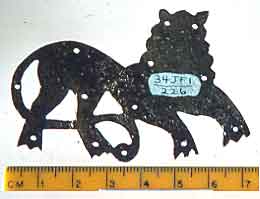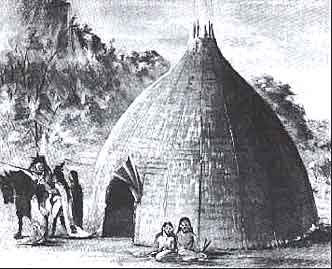Petersburg,
OK
Approximately 15 miles south of Ringling in extreme S.E.
Jefferson County lies the small farming community of Petersburg.
This community has a colorful history in its own right, but long
before the town ever existed, this area was already
populated by a rich culture. During the mid 1700's when
Oklahoma was part of Louisiana, the Taovayas (A tribe
of Wichita Indians) made their home here along both sides of
the Red River. Heavy trade was made with the French who made
their way to this area along the Red River from Louisiana. Near
present day Menard, Texas, a mission was built by the
Spanish and a fort was to be erected under the
orders of Diego Ortiz Parrila as protection. In
response to sporadic attacks on the mission and fort, Parrila and
500 soldiers marched from San Antonio to the Taovayas village on
the Red River in 1759. The Wichita warriors attacked and forced
the Spanish and their Apache allies to flee. The Spanish left
behind two cannons, which proved too difficult to maneuver in the
sandy soil along the south bank of the river. Accounts of the battle with the Taovayas
village have been translated in the original Spanish documents.
In a location along the north side of the Red
River, (Present day Jefferson County, OK.) the Taovayas had built
a circular stockade protected by an earthen rampart and moat.
According to the Spanish, the stockade had underground tunnels in
which people sheltered during an attack. Round, grass-thatch
houses made up the Taovayas village outside the stockade. A
Comanche camp of tall teepees along with the village of another
band of Wichita were reported in the immediate area. The Wichita
and their allies had many horses and were well-armed. The Spanish
reported extensive corn fields near the villages.

Brass gun ornament from
the site south of Ringling.
|
In 1965-1966, excavations at a site about
15 miles south of Ringling, revealed the Taovayas village
detailed in the Spanish records of the Parrilla
expedition. The site covered an area of 35-40 acres.
Situated above the Red River on a broad terrace, the site
is protected from flooding by its elevation. Circular
depressions with posthole patterns, trash mounds, storage
pits and many European (mostly French) trade items along
with traditional Wichita artifacts as well as skeletal
remains, were recovered in the excavations. The discovery
in aerial photos of a large circular stain in the soil
similar to those known for other archeological sites in
Oklahoma led to further excavations at this site.
Archeologists concluded the circular stain represented
evidence of the log stockade constructed by the Wichita
to protect their village. Today, the only reminder of this
thriving village is a roadside marker that sits along
Hwy. 89. The original historic site sits on private
property and is not open to the public. |

(click to enlarge) Marker reads: SAN
BERNARDO SITE IN
IMMEDIATE VICINITY WEST 'OKLAHOMA'S
OLDEST TOWN ON RED RIVER' THE
GREAT VILLAGE OF THE WICHITA INDIANS WITH A FRENCH TRADING POST
HERE WAS NAMED IN HONOR OF GOV. BERNARDO DE GALVEZ, IN 1778 WHEN
OKLAHOMA WAS A PART OF LOUISIANA.
OKLAHOMA HISTORICAL SOCIETY, 1950

(click to enlarge)
Area
looking west toward ancient Taovayas Indian Village

Information
submitted by: Richard
Wooley
~~~~~~~~~~
Here is more information about the Taovayas
Indians:
https://www.tshaonline.org/handbook/entries/taovaya-indians
Spanish Fort, Texas, a ghost town in Montague County.
National Register
of Historic Places site:
//www.nationalregisterofhistoricplaces.com/OK/Jefferson/state.html
San Bernardo
** (added 1982 - Site - #82003685)
Also known as Taovayas Village; Longest Site (JF-1); Spanish
Fort Sites
Address Restricted, Ringling 
| Historic Significance: |
Information Potential |
| Area of Significance: |
Historic - Aboriginal |
| Cultural Affiliation: |
Wichita, Taovayas |
| Period of Significance: |
1750-1799, 1800-1824 |
| Owner: |
Private |
| Historic Function: |
Domestic |
| Historic Sub-function: |
Village Site |
| Current Function: |
Agriculture/Subsistence |
| Current Sub-function: |
Agricultural Fields |
Chronicles of
Oklahoma
Volume 6, No. 2
June, 1928
SPANISH EXPLORATION OF OKLAHOMA 1599-1792
BY A. B. THOMAS,
PH. D. UNIVERSITY OF OKLAHOMA



